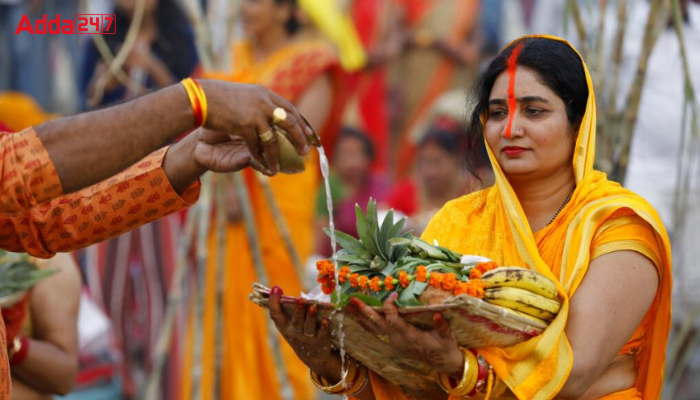By Manoj Singh, ex ACS, UP Govt
As the golden sun dips gently into the river and thousands of devotees stand immersed in its glow, the Chhath Festival unfolds as one of India’s most profound celebrations — not merely a religious event, but a living synthesis of spirituality, ecology, and community. Observed mainly in Bihar, Jharkhand, eastern Uttar Pradesh, and Nepal, Chhath Puja represents a worldview where nature, human life, and cosmic forces exist in seamless harmony.
A Solar Spirituality Beyond Temples
Unlike other Hindu festivals centered around deities and idols, Chhath is directed toward Surya, the Sun God, and Chhathi Maiya, the goddess of dawn and fertility. The worship is performed not in temples but on riverbanks, ponds, and open fields — where the divine is encountered directly through sunlight and water.
The ritual sequence — fasting, abstinence, bathing in holy waters, and offering ‘arghya’ to the setting and rising sun — represents a complete spiritual discipline. The devotee (known as vrati) undergoes intense purification, symbolizing the journey from the material to the cosmic. Offering obeisance first to the setting sun and then to the rising one embodies a deep metaphysical acceptance of dualities — creation and dissolution, joy and sorrow, life and death — as natural continuums of existence.
In a time when spirituality often leans toward consumption and spectacle, Chhath reminds India of its Vedic simplicity — of faith as discipline, devotion as balance, and divinity as nature itself.
Culture Rooted in Continuity
Culturally, Chhath is among the most ancient of Indian festivals, tracing back to Rigvedic solar hymns and myths of Karna, the sun-born warrior of the Mahabharata. Yet it has evolved into a distinct regional expression — an emblem of Bihari and eastern Indian identity, carried with reverence by migrants across India and abroad.
The rituals are characterized by folk aesthetics — bamboo baskets, sugarcane canopies, clay lamps, and handmade sweets (thekua) — all locally sourced and symbolically rich. The festival’s songs, sung in Bhojpuri, Maithili, and Magahi, transmit not only devotion but also oral histories and ecological wisdom.
In the humble household courtyards and riverbanks, Chhath becomes a folk art performance — where women, water, and sunlight weave a living tapestry of India’s rural civilization.
Social Harmony and Silent Power
What makes Chhath exceptional is its social inclusivity. It dissolves barriers of caste, class, and religion. On Chhath ghats, everyone — rich or poor, urban or rural — stands shoulder to shoulder in the same river, facing the same sun.
Women are the primary ritual leaders, observing the rigorous fast and guiding families through generations of tradition. Yet, men participate equally in preparation and worship. This gendered collaboration — where female asceticism commands respect and authority — makes Chhath a quiet assertion of women’s moral and spiritual power in a patriarchal society.
The festival also strengthens social solidarity. In villages and cities alike, communities come together to clean riverbanks, arrange bamboo platforms, and assist devotees. In an era of urban alienation, Chhath reawakens collective consciousness and civic responsibility.
Metaphysical and Ontological Dimensions
Philosophically, Chhath represents a phenomenology of light — an encounter between human consciousness and the cosmic principle of illumination. The sun, as worshipped here, is not merely a celestial body but a visible metaphor of the invisible Absolute.
When the vrati offers water to the sun, the reflection in the river merges the human and the cosmic — a symbolic realization that the self and the universe are mirrors of one another.

The offering to the setting sun acknowledges the truth of impermanence; the offering to the rising sun celebrates renewal. Existence, in this view, is cyclical — not a march toward progress but a rhythm of being.
In this ontological sense, Chhath articulates a philosophy of relational being: humans exist with nature, not against it. The river, the air, the sun, and the devotee form an unbroken field of sacred interdependence.
An Anthropological Mirror of Indian Civilization
Anthropologists view Chhath as a ritual ecology — a cultural system that encodes agricultural cycles, environmental awareness, and social ethics. Its emphasis on purity, sunlight, and water points to early agrarian societies’ dependence on solar and riverine systems.
The symbolic objects — bamboo baskets, fruits, grains — represent sustainability and reciprocity. Every item is biodegradable, every act embedded in ecological respect.
The fasting woman undergoes what anthropologist Arnold van Gennep would call a rite of passage — a process of separation, transition, and reintegration — embodying the universal human search for transformation through ritual.
Economic Resonance of a Ritual Economy
Though deeply spiritual, Chhath has tangible economic implications. In Bihar alone, the festival generates a vast seasonal informal economy. Local artisans, potters, fruit vendors, and weavers see a surge in demand for traditional goods.
Handmade items — bamboo soops, clay lamps, baskets — sustain rural livelihoods and reinforce indigenous craftsmanship. Even urban celebrations stimulate local trade, transport, and hospitality.
Beyond money, the festival mobilizes enormous voluntary labor for river cleaning and environmental upkeep — creating what economists might call a “moral economy of sustainability.”
The Living Philosophy of Chhath
Ultimately, Chhath is not only a festival but a living metaphysical act. It teaches gratitude to the sun that sustains life, reverence for water that reflects it, and humility for the human who depends on both.
It is India’s oldest solar humanism — where spirituality, ecology, gender, and community converge in a harmony the modern world often forgets.
At a time of climate anxiety and cultural fragmentation, Chhath stands as a timeless message:
“To live well is to live in balance — with nature, with others, and with oneself.”






